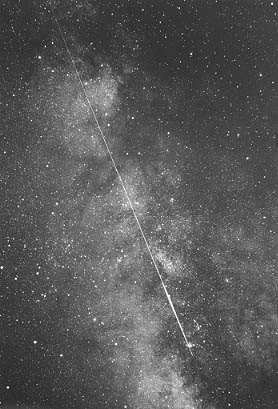
| The sky is quite clear in the wake of a typhoon. I arrived at the observatory
on the evening of August 4 to start searching for new objects. The main
telescope for this purpose was 60cm f/3.5 reflector. The Mamiya Press (90mm
f/3.5) set up for meteor search in the second observatory captured a bright
meteor at 22.26. The long streak crossing the Milky Way lengthwise changed
its color from blue to red. It was magnitude minus 4 and we called it a
"Ginga Tetsudo Meteor" or Galaxy Railway meteor named after the
well-known Japanese poet Kenji Miyazawa's work. This is a precursor of
Perseids. Fading LINEAR was not visible any longer in the 20cm refractor on the evening of August 3. In the 60cm telescope the comet was pathetic at a photographical magnitude 10.5 and appeared as an extremely dim nebulosity. On August 4 it was only magnitude 12.5, tiny remnants of the comet. On the film it could be mistaken for an unevenness caused by incorrect developing, not suitable for printing. It must have ended up in dust in space by now. According to the orbit calculated by Mr. Muraoka, the comet's period is about 50,000 years. The comet traveled for about 25,000 years from aphelion (in the Oort Cloud?) only to end its life like this. |

A meteor in the Milky Way
22.26 on August 4, 2000
Mamiya Press 90 f/3.5 lens
Tsutomu Seki at Geisei Observatory
Copyright (C) 2000 Tsutomu Seki.